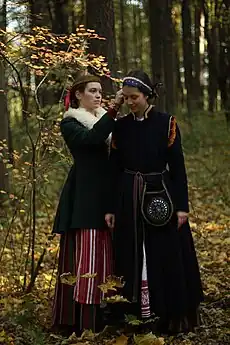
Delmonas (or Dalmonas, plural delmonai) – is a detail of folk costume of women originated in Lithuania Minor. It is an elaborately decorated purse, visibly attached to the waist by a band. This costume feature represents the Prussian Lithuanians and is not common to other ethnographic regions of Lithuania. In 2019 Delmonai of Lithuania Minor were inscribed into The Intangible Cultural Heritage Inventory of Lithuania as a form of folk art, traditional craftsmanship or agricultural activities.[1]
Traditional appearance
Delmonas was usually sewn from velvet, wool, silk or cotton. Traditionally the color of fabric was dark, and delmonas was embroided using colorful threads and glass beads. Embroidery usually depicted flowers or other plants, birds, and sometimes the initials of the owner.[2] Also some meaningful quotes, dates or initials, sometimes figurines could be embroided on a rectangle, rounded, flare, wavy bottom, trapezium, multiangular or other shape pocket. Delmonai were usually embroided by the women of Lithuania Minor themselves; however, they could also order delmonai from a tailor as well.[3]
Usage and history
Worn at the end of the 18th century – beginning of the 20th century – when region was a part of the Kingdom of Prussia – delmonai served a certain practical function. Women could store small items while doing house chores or use it as a pocket going outside. This practical feature was not hidden at first – dalmonai was the most decorated item of the costume. However, during various political turmoil women of Lithuania Minor started to wear dalmonai secretly. They would be hidden under the skirt and used to hide money, documents or letters, especially for women who were willing or forced to leave their homeland. Many of such women would pass delmonai to younger generations, who would then donate them for various museums of Lithuania.[4] Women of Klaipėda city reportedly continued to wear delmonai up to 1940s.[5] The popularity of delmonai was restored in the revival of folk costume in 1960s and 1970s. Being used as a sign of Lithuania Minor identity, delmonai are also used as a modern accessory, continuing the uninterrupted production in Klaipėda region.[6]
Gallery
 Examples of folk costumes from Lithuania Minor. Dalmonas is shown as a part of woman's costume
Examples of folk costumes from Lithuania Minor. Dalmonas is shown as a part of woman's costume_with_national_costumes%252C_painted_in_the_19th_century.jpg.webp) 19th Century Prussian Lithuanians with national costumes
19th Century Prussian Lithuanians with national costumes 2015 Lithuanian postage stamp, commemorating the traditional embroidery of delmonas
2015 Lithuanian postage stamp, commemorating the traditional embroidery of delmonas
Sources
- ↑ "Delmonai of Lithuania Minor". savadas.lnkc.lt. Lithuanian National Culture Centre. Retrieved May 4, 2023.
- ↑ Jurkuvienė T., 2008, Lietuvių tautinis kostiumas
- ↑ "Delmonai of Lithuania Minor". savadas.lnkc.lt. Lithuanian National Culture Centre. Retrieved May 4, 2023.
- ↑ "Delmonai of Lithuania Minor". savadas.lnkc.lt. Lithuanian National Culture Centre. Retrieved May 4, 2023.
- ↑ Marija Miliuvienė. "Delmonas". www.vle.lt. Science and Encyclopaedia Publishing Institute (Universal Lithuanian Encyclopedia). Retrieved May 4, 2023.,
- ↑ "Delmonai of Lithuania Minor". savadas.lnkc.lt. Lithuanian National Culture Centre. Retrieved May 4, 2023.